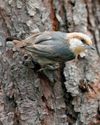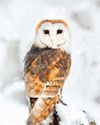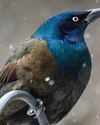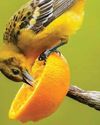
SOUTHBOUND
Common murres are permanent residents in some areas, but some are forced to travel south in the winter when the water near their coastal colonies freezes.
AUTUMN IS MIGRATION SEASON. All over North America and beyond, hundreds of millions of birds are on the move, traveling from their breeding grounds to their wintering grounds. But they don't all travel in the same ways. Some migrate in flocks and some alone; certain birds move at night, others by day; some travel more than halfway around the globe, while certain birds shift only a few miles to a slightly different habitat. There are almost as many approaches as there are species of migratory birds. Here are just a few migration variations.
Wintering Within Walking Distance
Spruce grouse in northern forests have some of the easiest migrations imaginable. Individuals have summer and winter territories that are usually less than 10 miles apart, so they migrate by walking early in the morning-going perhaps half a mile per day - and then resting. In mountains of the West, dusky grouse are also short-distance travelers. They migrate partly by walking and partly by flying, and they often move to areas of denser forest in higher elevations to spend the winter.
Swimming to New Waters
Denne historien er fra October/November 2024-utgaven av Birds & Blooms.
Start din 7-dagers gratis prøveperiode på Magzter GOLD for å få tilgang til tusenvis av utvalgte premiumhistorier og 9000+ magasiner og aviser.
Allerede abonnent ? Logg på
Denne historien er fra October/November 2024-utgaven av Birds & Blooms.
Start din 7-dagers gratis prøveperiode på Magzter GOLD for å få tilgang til tusenvis av utvalgte premiumhistorier og 9000+ magasiner og aviser.
Allerede abonnent? Logg på

Basics of Hydroponics
Use these top tips and plant picks to have a successful soil-free garden

Rooted in Resilience
These hardy perennials will thrive in most zones

Social and Supportive
Brown-headed nuthatches take a helpful approach to raising their young

All About Owl Pellets
And why you should give a hoot about them

Ask the Experts
Advice from our pros about houseplants, bird feeding and more

BRING THE OUTDOORS IN
Making a terrarium is about as close as you can get to a Zen DIY project. Once you have gathered the proper materials and squared away your plant selections, it's as simple as layering it all together and watching your mini ecosystem thrive. Here, I'll walk you through my foolproof process and cover all the required elements for good filtration, healthy soil, strong root growth and resistance against fungus and disease.

GROW THIS. NOT THAT
Six easy-to-grow houseplants—and six that may not be the right choice for you

Winter MAGIC
Forecasts may be frigid, but grab your binoculars because birding opportunities are still incredible

Sense or Nonsense? - Why some birds can taste and smell - but others can't
Does a porcelain berry taste like a blueberry to a gray catbird? Does a block of lard smell like frying bacon to a northern flicker? The short answer is no. While some avian species do have a well-adapted sense of taste or smell, they can't distinguish between flavors and odors the way humans can. They're not picking up every ingredient in the suet you put out, says José Ramírez-Garofalo, an ornithology researcher at Rutgers University in New Jersey and the director of Freshkills Biological Station in Staten Island, New York.

Maple Mania - Amazing facts about this fall foliage mainstay
Amazing facts about this fall foliage mainstay